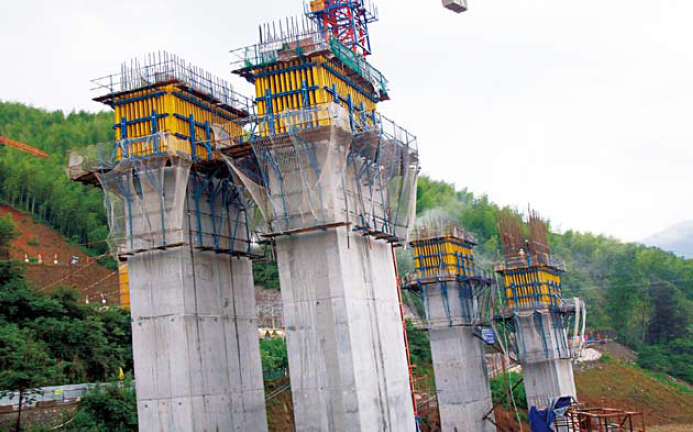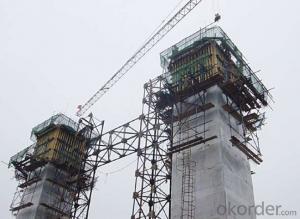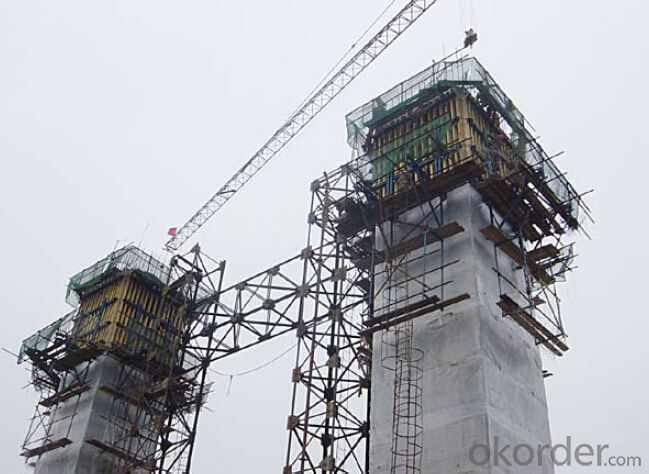Climbing Bracket for Formwork and Scaffolding System
- Loading Port:
- Tianjin
- Payment Terms:
- TT OR LC
- Min Order Qty:
- 50 m²
- Supply Capability:
- 1000 m²/month
OKorder Service Pledge
OKorder Financial Service
You Might Also Like
Climbing Bracket CB240 & CB210
They are framework brackets for supporting large-area wall formwork.
Typical applications for the CB240&CB210 are pier and column/shear wall/core walll/ in the
building.
CB210 has smaller size than CB240, it will be cost effective in some condition.
Characteristics:
◆ High bearing capacity
The high loading capacity of the brackets allow very large scaffold units. This saves the number
anchor points required as well as reducing climbing times.
◆ Simple moving procedure by crane
Through the strong connection of formwork together with the climbing scaffold, both can be moved
as a single climbing unit by crane. Thus valuable time-savings can be achieved.
◆ Fast striking process without a crane
With the retrusive set, large formwork elements can also be retracted quickly and a minimum of
effort.
◆ Safe with work platform
The platforms have assembled firmly with bracket and will be climbing together, without scaffolding
but can work safely in spite of your high location.


- Q: What are the different types of ties used in steel formwork construction?
- There are several types of ties commonly used in steel formwork construction, including steel wire ties, snap ties, wedge ties, and coil ties. Each type of tie is designed to securely hold the formwork together and provide stability during the concrete pouring process. Steel wire ties are typically used for light-duty applications, while snap ties, wedge ties, and coil ties are more commonly used for heavy-duty formwork construction.
- Q: How does steel formwork affect the overall quality control of a construction project?
- Steel formwork can have a significant impact on the overall quality control of a construction project. Firstly, steel formwork provides a higher level of precision and accuracy compared to other types of formwork materials such as wood or plastic. This enables construction teams to achieve more precise dimensions and shapes, resulting in a higher quality finished product. Additionally, steel formwork offers better durability and stability, which reduces the risk of deformations or damages during the concrete pouring process. This ensures that the final structure maintains its integrity and structural stability over time. The use of steel formwork also minimizes the occurrence of surface imperfections, such as cracks or unevenness, which can significantly affect the aesthetic appearance and overall quality of the construction project. Furthermore, steel formwork allows for faster construction cycles, as it is reusable and can be easily assembled and dismantled. This not only saves time but also helps to maintain consistency in the construction process, leading to improved quality control. The ability to reuse steel formwork also reduces waste and environmental impact, promoting sustainable construction practices. Another important aspect of steel formwork is its ability to withstand high pressures and loads, making it suitable for constructing complex structures and high-rise buildings. This strength and stability contribute to the overall safety and resilience of the construction project, further enhancing its quality control. In conclusion, steel formwork positively affects the overall quality control of a construction project by offering precision, durability, stability, speed, and safety. Its use ensures that the construction project meets the desired standards, resulting in a high-quality final product that meets both functional and aesthetic requirements.
- Q: How does steel formwork affect the speed of construction?
- Steel formwork can greatly enhance the speed of construction due to its numerous advantages. Firstly, steel formwork is highly durable and can withstand repeated use, allowing for multiple pours to be completed without the need for replacement or repair. This eliminates the downtime associated with traditional timber formwork, where the forms often need to be replaced after only a few uses. Additionally, steel formwork is known for its ease of assembly and disassembly. The modular nature of steel formwork allows for quick and efficient installation, reducing the overall construction time. This is particularly beneficial for large-scale projects where time is of the essence. Furthermore, steel formwork offers excellent dimensional accuracy and stability, ensuring precise and uniform construction. This eliminates the need for excessive rework and adjustments, saving both time and resources. Steel formwork is also known for its ability to handle high concrete pressures. This allows for faster pouring and setting of concrete, as there is no need to wait for the formwork to be fully cured before proceeding to the next pour. This results in faster construction cycles and increased productivity. Lastly, steel formwork is compatible with various construction techniques and can be easily adapted to suit different project requirements. It can be used for a wide range of applications, from simple slabs and columns to complex structures, enabling faster construction of diverse building elements. Overall, steel formwork significantly speeds up the construction process by offering durability, ease of use, dimensional accuracy, and compatibility with different construction techniques. Its ability to handle high concrete pressures and its modular nature contribute to faster construction cycles and increased productivity, making it an ideal choice for efficient construction projects.
- Q: What are the different types of finishes available for steel formwork panels?
- Steel formwork panels offer a range of finishes, each with its own advantages and uses. 1. The smooth finish is the most commonly used for steel formwork panels. It ensures a clean and precise concrete surface, making it perfect for projects that require high-quality results, such as architectural structures or exposed concrete elements. 2. Textured finishes provide decorative or non-slip surfaces on the steel formwork panels. They can be achieved through methods like brushing, sandblasting, or applying textured coatings. These finishes are commonly used for pedestrian walkways, ramps, or areas that require good traction. 3. Patterned finishes add a unique aesthetic appeal to the concrete surface. They can be achieved by incorporating patterns or designs into the steel formwork panels, such as stamped or embossed patterns. Patterned finishes are often used in decorative applications like building facades, retaining walls, or interior wall panels. 4. Coated finishes involve the application of a protective coating to the steel formwork panels. This can be a paint or a specialized protective material like epoxy or polyurethane. Coated finishes provide added durability, corrosion resistance, and weather resistance, making them suitable for long-term use in harsh environments. 5. Polished finishes involve polishing the steel formwork panels to create a reflective surface. This type of finish is commonly used in architectural or decorative applications when a high-gloss, mirror-like appearance is desired. Polished finishes enhance the aesthetics of the concrete surface and create a visually striking effect. When choosing the finish for steel formwork panels, it is important to consider the specific requirements of the project, including surface quality, functionality, and aesthetics. Factors like durability, maintenance ease, cost, and environmental impact should also be taken into account.
- Q: What are the different types of formwork corners used in steel formwork systems?
- There are typically three types of formwork corners used in steel formwork systems: external corners, internal corners, and chamfer corners. External corners are used to create sharp outside corners in the concrete structure. Internal corners are used to create sharp inside corners in the concrete structure. Chamfer corners are used to create beveled edges or rounded corners in the concrete structure. These different types of corners allow for flexibility in the design of the concrete structure and ensure a smooth and precise finish.
- Q: How does steel formwork prevent concrete bleeding?
- Steel formwork prevents concrete bleeding by providing a rigid structure that holds the concrete in place, preventing it from flowing or seeping out from the formwork. This containment of the concrete prevents the separation of water from the mixture, which is the primary cause of bleeding.
- Q: Can steel formwork be used for staircases and ramps?
- Steel formwork is indeed capable of being utilized for the construction of staircases and ramps. It possesses a great deal of versatility and durability, making it an ideal choice for the creation of intricate shapes and structures. The strength and stability that it offers are essential for supporting the weight and loadings associated with staircases and ramps. Moreover, the assembly and disassembly of steel formwork can be accomplished with ease, allowing for efficient construction and customization of staircases and ramps. Its flexibility enables the creation of diverse designs and sizes that cater specifically to the requirements of a given project. In conclusion, when considering the construction of staircases and ramps, the use of steel formwork is highly suitable due to its strength, durability, versatility, and user-friendly nature.
- Q: Can steel formwork be used for both regular and irregular concrete structures?
- Yes, steel formwork can be used for both regular and irregular concrete structures. Steel formwork is highly versatile and can be easily adjusted or modified to suit the specific shape and design requirements of any concrete structure, whether it is regular or irregular in shape. Its strength, durability, and flexibility make it the preferred choice for various construction projects.
- Q: How does steel formwork affect the overall construction site dust control?
- Steel formwork can have a positive impact on overall construction site dust control. Compared to other types of formwork, such as wooden or plastic, steel formwork is more durable and less likely to wear down or break, which can generate dust particles. This means that there will be less dust generated during the construction process. Additionally, steel formwork is typically designed to fit tightly together, reducing the gaps and spaces where dust can accumulate. This results in a cleaner and more controlled construction site environment, as there will be fewer areas for dust to settle and become airborne. Furthermore, steel formwork can be reused multiple times, which reduces the need for frequent replacements. This minimizes the amount of waste generated, including dust-producing debris from formwork removal and replacement. Overall, the use of steel formwork contributes to better dust control on construction sites, promoting a safer and healthier work environment for workers and reducing the potential negative impacts of dust on nearby communities and the environment.
- Q: Can steel formwork be used for both horizontal and vertical concrete elements?
- Yes, steel formwork can be used for both horizontal and vertical concrete elements. Steel formwork provides strength, stability, and durability, making it suitable for a wide range of construction projects. Its versatility allows for the creation of various shapes and sizes, making it a preferred choice for both horizontal slabs and vertical walls.
Send your message to us
Climbing Bracket for Formwork and Scaffolding System
- Loading Port:
- Tianjin
- Payment Terms:
- TT OR LC
- Min Order Qty:
- 50 m²
- Supply Capability:
- 1000 m²/month
OKorder Service Pledge
OKorder Financial Service
Similar products
Hot products
Hot Searches



















